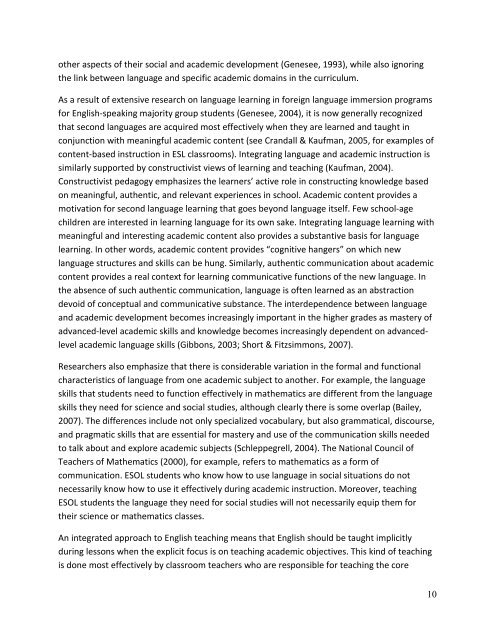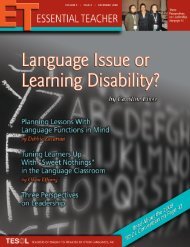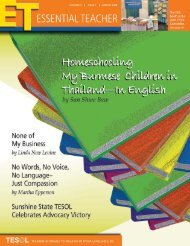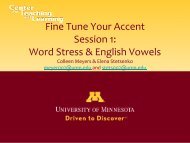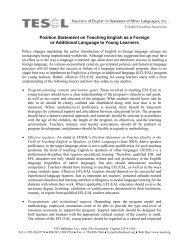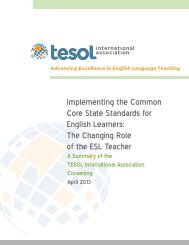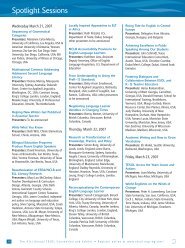Standards for the Recognition of Initial TESOL Programs
Standards for the Recognition of Initial TESOL Programs
Standards for the Recognition of Initial TESOL Programs
You also want an ePaper? Increase the reach of your titles
YUMPU automatically turns print PDFs into web optimized ePapers that Google loves.
o<strong>the</strong>r aspects <strong>of</strong> <strong>the</strong>ir social and academic development (Genesee, 1993), while also ignoring<br />
<strong>the</strong> link between language and specific academic domains in <strong>the</strong> curriculum.<br />
As a result <strong>of</strong> extensive research on language learning in <strong>for</strong>eign language immersion programs<br />
<strong>for</strong> English-speaking majority group students (Genesee, 2004), it is now generally recognized<br />
that second languages are acquired most effectively when <strong>the</strong>y are learned and taught in<br />
conjunction with meaningful academic content (see Crandall & Kaufman, 2005, <strong>for</strong> examples <strong>of</strong><br />
content-based instruction in ESL classrooms). Integrating language and academic instruction is<br />
similarly supported by constructivist views <strong>of</strong> learning and teaching (Kaufman, 2004).<br />
Constructivist pedagogy emphasizes <strong>the</strong> learners’ active role in constructing knowledge based<br />
on meaningful, au<strong>the</strong>ntic, and relevant experiences in school. Academic content provides a<br />
motivation <strong>for</strong> second language learning that goes beyond language itself. Few school-age<br />
children are interested in learning language <strong>for</strong> its own sake. Integrating language learning with<br />
meaningful and interesting academic content also provides a substantive basis <strong>for</strong> language<br />
learning. In o<strong>the</strong>r words, academic content provides “cognitive hangers” on which new<br />
language structures and skills can be hung. Similarly, au<strong>the</strong>ntic communication about academic<br />
content provides a real context <strong>for</strong> learning communicative functions <strong>of</strong> <strong>the</strong> new language. In<br />
<strong>the</strong> absence <strong>of</strong> such au<strong>the</strong>ntic communication, language is <strong>of</strong>ten learned as an abstraction<br />
devoid <strong>of</strong> conceptual and communicative substance. The interdependence between language<br />
and academic development becomes increasingly important in <strong>the</strong> higher grades as mastery <strong>of</strong><br />
advanced-level academic skills and knowledge becomes increasingly dependent on advancedlevel<br />
academic language skills (Gibbons, 2003; Short & Fitzsimmons, 2007).<br />
Researchers also emphasize that <strong>the</strong>re is considerable variation in <strong>the</strong> <strong>for</strong>mal and functional<br />
characteristics <strong>of</strong> language from one academic subject to ano<strong>the</strong>r. For example, <strong>the</strong> language<br />
skills that students need to function effectively in ma<strong>the</strong>matics are different from <strong>the</strong> language<br />
skills <strong>the</strong>y need <strong>for</strong> science and social studies, although clearly <strong>the</strong>re is some overlap (Bailey,<br />
2007). The differences include not only specialized vocabulary, but also grammatical, discourse,<br />
and pragmatic skills that are essential <strong>for</strong> mastery and use <strong>of</strong> <strong>the</strong> communication skills needed<br />
to talk about and explore academic subjects (Schleppegrell, 2004). The National Council <strong>of</strong><br />
Teachers <strong>of</strong> Ma<strong>the</strong>matics (2000), <strong>for</strong> example, refers to ma<strong>the</strong>matics as a <strong>for</strong>m <strong>of</strong><br />
communication. ESOL students who know how to use language in social situations do not<br />
necessarily know how to use it effectively during academic instruction. Moreover, teaching<br />
ESOL students <strong>the</strong> language <strong>the</strong>y need <strong>for</strong> social studies will not necessarily equip <strong>the</strong>m <strong>for</strong><br />
<strong>the</strong>ir science or ma<strong>the</strong>matics classes.<br />
An integrated approach to English teaching means that English should be taught implicitly<br />
during lessons when <strong>the</strong> explicit focus is on teaching academic objectives. This kind <strong>of</strong> teaching<br />
is done most effectively by classroom teachers who are responsible <strong>for</strong> teaching <strong>the</strong> core<br />
10


